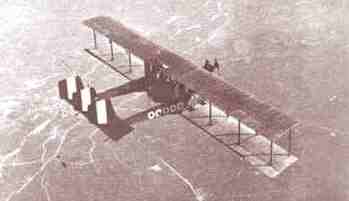 |
AIRCRAFTOF THEA E F |
Caproni Ca.3

Development and Operation
The Caproni three-engined bomber appeared in 1914, powered by three Gnome rotary engines. The production version, equipped with three 100 hp fixed in-line Fiat A 10 engines entered service in the summer of 1915, and it was the most effective bomber of any air force, excluding the Russian Sikorsky. |
Aircraft and Flight Characteristics
|
Length |
11.05 m |
|
Height |
3.85 m |
|
Empty Weight |
2,650 kg |
|
Loaded Weight |
3,650 kg |
|
Maximum Speed |
137 km/hr. |
|
Wing Span |
22.74 m |
|
Ceiling |
4,100 m |
|
Climb |
|
|
To 1,000 m |
6 minutes |
|
To 2,000 m |
14 minutes |
|
To 3,000 m |
26 minutes |
|
Endurance |
4 h 45 min |
References:
- Montecelio Test Establishment Report
- Photo courtesy of Roberto Gentilli
To find other Doughboy Features visit our |
Membership Information  Click on Icon |
For further information on the events of 1914-1918
visit the homepage of |
Michael E. Hanlon (medwardh@hotmail.com) regarding content,
or toMike Iavarone (mikei01@execpc.com) regarding form and function.
Original artwork & copy; © 1998-2000, The Great War Society